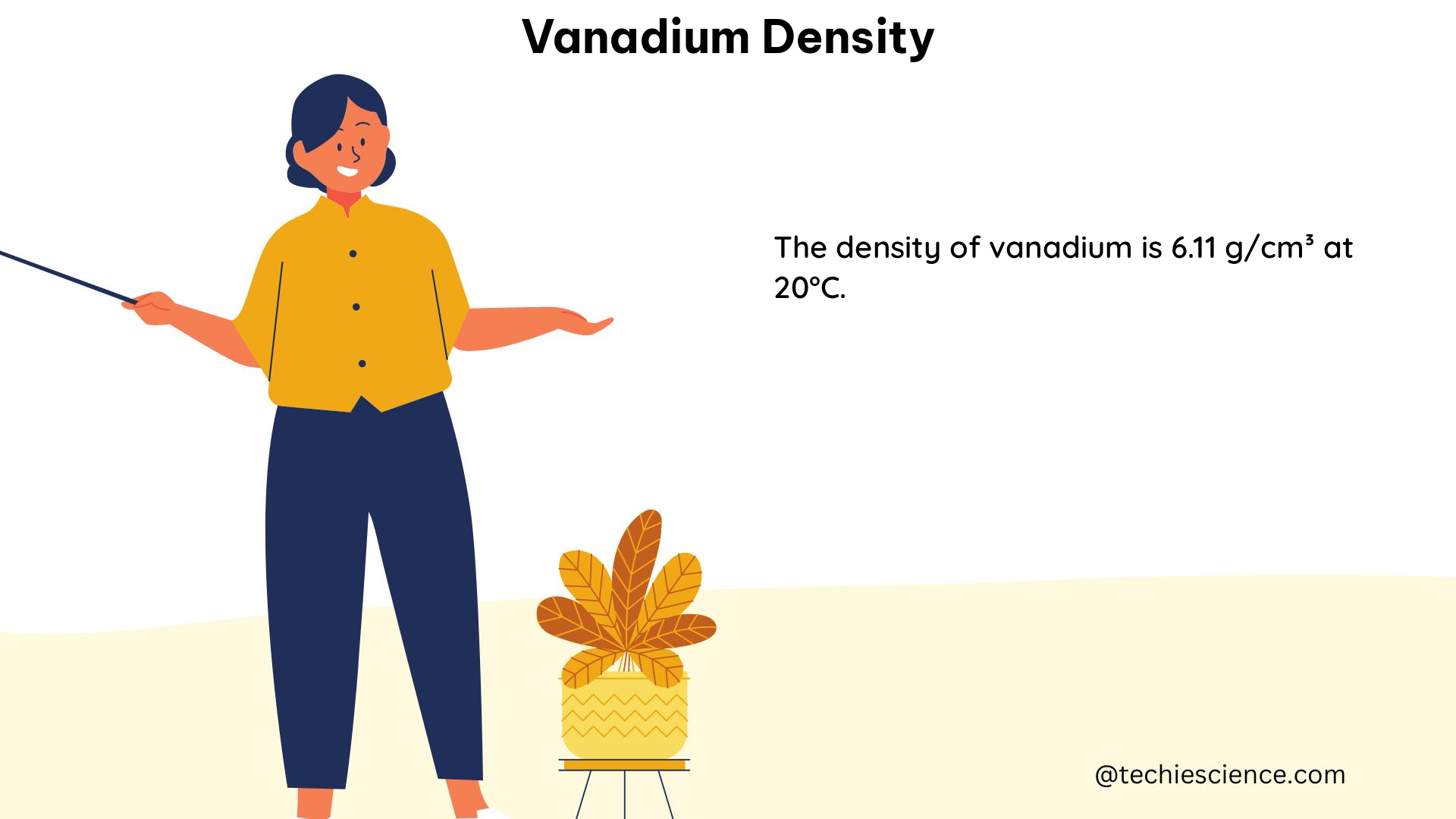Vanadium density is a crucial parameter in Vanadium Redox Flow Batteries (VRFBs), which are energy storage systems that utilize vanadium electrolytes in different oxidation states to store and release energy. The density of vanadium electrolytes varies with several parameters, including State of Charge (SoC), total vanadium concentration, total sulfate concentration, and temperature. This comprehensive guide will delve into the technical details and provide a hands-on understanding of vanadium density in VRFBs.
Understanding Vanadium Density in VRFBs
Relationship between Vanadium Density and State of Charge (SoC)
In a VRFB, the density of the positive electrolyte (posolyte) slightly increases with SoC, while the negative electrolyte (negolyte) decreases more significantly. Specifically, the posolyte density increases by approximately 0.001 g/cm³ when the SoC increases from 0% to 100%, while the negolyte density decreases by around 0.01 g/cm³ over the same SoC range.
This relationship can be expressed mathematically as:
ρ_posolyte = ρ_posolyte,0 + 0.001 × SoC
ρ_negolyte = ρ_negolyte,0 - 0.01 × SoC
where ρ_posolyte and ρ_negolyte are the densities of the posolyte and negolyte, respectively, and ρ_posolyte,0 and ρ_negolyte,0 are the initial densities at 0% SoC.
Impact of Temperature on Vanadium Density
Temperature also impacts the density of both electrolytes linearly. For instance, a 10°C increase in temperature results in a 0.006 g/cm³ increase in posolyte density and a 0.012 g/cm³ increase in negolyte density. This relationship can be expressed as:
ρ_posolyte = ρ_posolyte,T0 + 0.0006 × (T - T0)
ρ_negolyte = ρ_negolyte,T0 + 0.0012 × (T - T0)
where T0 is the reference temperature, and T is the actual temperature.
Viscosity of Vanadium Electrolytes
Viscosity, another physical property of vanadium electrolytes, exhibits complex and non-linear dependencies on SoC, total vanadium concentration, total sulfate concentration, and temperature. The viscosities of both electrolytes decrease with SoC, with the negolyte consistently having a higher viscosity than the posolyte.
The relationship between viscosity and these parameters can be expressed using empirical models, such as the Vogel-Fulcher-Tammann (VFT) equation:
η = A × exp(B / (T - T0))
where η is the viscosity, A, B, and T0 are empirical constants that depend on the electrolyte composition and SoC.
Measurement Techniques for Vanadium Density and Viscosity
To accurately measure the density and viscosity of vanadium electrolytes, extensive and accurate measurements were conducted over a four-dimensional parameter space, including SoC, total vanadium concentration, total sulfate concentration, and temperature. These measurements provide valuable insights into the dynamic behavior of vanadium electrolytes and enable more accurate physics-based mathematical models.
Some of the key measurement techniques include:
-
Density Measurement: Density can be measured using a pycnometer or a digital density meter, which provide precise measurements of the electrolyte density.
-
Viscosity Measurement: Viscosity can be measured using a rotational viscometer, which determines the resistance of the electrolyte to flow under a controlled shear rate.
-
UV-Vis Spectroscopy: This technique can be used to measure the total vanadium concentration and state of charge of vanadium electrolytes, which are crucial parameters for determining the density and viscosity.
Table 1 provides a summary of the typical ranges and dependencies of vanadium density and viscosity in VRFBs:
| Parameter | Typical Range | Dependency |
|---|---|---|
| Posolyte Density | 1.30 – 1.35 g/cm³ | Increases by 0.001 g/cm³ per 100% SoC increase, Increases by 0.0006 g/cm³ per 10°C temperature increase |
| Negolyte Density | 1.30 – 1.40 g/cm³ | Decreases by 0.01 g/cm³ per 100% SoC increase, Increases by 0.0012 g/cm³ per 10°C temperature increase |
| Posolyte Viscosity | 2 – 5 cP | Decreases with increasing SoC, Decreases with increasing temperature |
| Negolyte Viscosity | 5 – 15 cP | Decreases with increasing SoC, Decreases with increasing temperature |
Figure 1 illustrates the typical trends of vanadium density and viscosity with respect to SoC and temperature.
Practical Applications and Considerations

Accurate knowledge of vanadium density and viscosity is crucial for the design, optimization, and operation of VRFBs. Some key applications and considerations include:
-
Electrolyte Management: Understanding the density and viscosity changes with SoC, temperature, and other parameters helps in the design of electrolyte management systems, such as pumps, tanks, and piping.
-
Performance Modeling: Incorporating the density and viscosity data into physics-based mathematical models enables more accurate predictions of VRFB performance, including energy efficiency, power output, and capacity.
-
Electrolyte Preparation: Knowing the density and viscosity dependencies helps in the preparation of vanadium electrolytes with desired properties, such as optimizing the total vanadium and sulfate concentrations.
-
State of Charge Estimation: Measuring the density and viscosity of vanadium electrolytes can provide indirect methods for estimating the SoC, which is crucial for the efficient operation of VRFBs.
-
Electrolyte Monitoring: Continuous monitoring of vanadium density and viscosity can help detect changes in electrolyte composition, which can indicate potential issues or degradation in the VRFB system.
By understanding the technical details and practical applications of vanadium density in VRFBs, researchers, engineers, and technicians can optimize the design, operation, and maintenance of these energy storage systems, ultimately improving their performance and reliability.
References
- Modelling and Estimation of Vanadium Redox Flow Batteries – MDPI: https://www.mdpi.com/2313-0105/8/9/121
- A comprehensive guide for measuring total vanadium concentration and state of charge of vanadium electrolytes using UV-Visible spectroscopy: https://www.researchgate.net/publication/372684091_A_comprehensive_guide_for_measuring_total_vanadium_concentration_and_state_of_charge_of_vanadium_electrolytes_using_UV-Visible_spectroscopy
- Determining Vanadium Concentrations Using the UV-Vis Response: https://iopscience.iop.org/article/10.1149/2.0371504jes
- A comprehensive guide for measuring total vanadium concentration and state of charge of vanadium electrolytes: https://www.sciencedirect.com/science/article/abs/pii/S0013468624002470
- Measuring density and viscosity of vanadium electrolytes – ChemRxiv: https://chemrxiv.org/engage/chemrxiv/article-details/65fac53d66c138172962dc12

The lambdageeks.com Core SME Team is a group of experienced subject matter experts from diverse scientific and technical fields including Physics, Chemistry, Technology,Electronics & Electrical Engineering, Automotive, Mechanical Engineering. Our team collaborates to create high-quality, well-researched articles on a wide range of science and technology topics for the lambdageeks.com website.
All Our Senior SME are having more than 7 Years of experience in the respective fields . They are either Working Industry Professionals or assocaited With different Universities. Refer Our Authors Page to get to know About our Core SMEs.